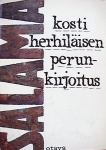Yankee revue troupe in Seoul, 1930
 Yankee Revue troupe's masquerade street parade Chosun Ilbo, April 20, 1930. Drawing and text: Sôgyông(夕影) An Sôk-yông Published in Modôn ppoi Kyôngsônhûl kônilda: Manmun manhwaro ponûn kûndaeûi ôlgul ("Modern boy strolling in Seoul: faces of modernity in illustrated newspaper columns") by Sin Myông-jik. (Hyônsilmunhwayôn'gu, 2003) Categories at del.icio.us/hunjang: culturalhistory |


Comments to note "Yankee revue troupe in Seoul, 1930" (Comments to posts older than 14 days are moderated)
I love it! How did you happen to come across this? So, this is an American troupe in Seoul... what brought them here? I'd love to know more. Thanks for sharing it!
This is from Modôn ppoi Kyôngsônhûl kônilda ("Modern boy strolling in Seoul") a book by Sin Myông-jik depicting the arrival of modernity in Korea at the time of Japanese colonial era through this kind of manmun manhwa illustrated newspaper columns.
Write a Comment